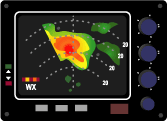 |
||||||||
| Issue Number 266 |
October
2001
|
|||||||
|
P.O. Box 189, Moffett Field, CA 94035-0189 |
||||||||
|
|
||||||||
 |
||||||||
| Issue Number 266 |
October
2001
|
|||||||
|
P.O. Box 189, Moffett Field, CA 94035-0189 |
||||||||
|
|
||||||||
Weather-Avoidance Radar Incidents
Proper
operation and interpretation of airborne weather avoidance radar is
dependent on pilots having a full understanding of its capabilities
and limits. Factors such as radar attenuation (de flection
or absorption of the radar beam by precipitation or solid objects
like terrain), and use of the radar's tilt and gain controls, may
affect the accuracy of radar returns.
flection
or absorption of the radar beam by precipitation or solid objects
like terrain), and use of the radar's tilt and gain controls, may
affect the accuracy of radar returns.
Even when none of these factors seem to be involved, pilots can still be surprised by adverse weather that is not accurately depicted on their weather radar, including severe turbulence, lightning strikes, inflight icing, and even microburst activity. More from a recent ASRS report:
This crew did what they were trained to do - fly attitude. Many air carriers require that flight crews maintain established distances from weather radar echoes according to the color of the radar return. This policy lessens the risk of adverse weather encounters, including hail thrown into clear air by thunderstorm "overhangs."
Onboard weather radar equipment itself may be hazardous, as described in this Captain's unusual report to ASRS:
Prolonged exposure to weather radar radiation may cause injury to ground personnel and damage to ground equipment in close proximity. An aircraft's radar receiver may also be damaged as the result of strong returns from nearby metallic objects such as other airplanes. The design of the transponder switch and the crew's faulty performance of the checklist were also factors in this incident.
The Three C's Revisited
"Climb, Communicate, Confess" - following this advice has undoubtedly saved the lives of many VFR pilots who inadvertently flew into clouds or IMC weather beyond their capability. It is advice taken to heart even by professional pilots with thousands of flight hours - including this EMS helicopter pilot whose adventure began when an emergency call was received at night:
The Three C's Forgotten
Our next reporter was intent on building his multi-engine time. He cut a good deal (or so he thought) with an entrepreneurial "old-timer" — but ended a cross-country flight lucky to be in one piece, and a lot wiser.
This incident brings to mind three other C’s that were sadly lacking throughout this flight: good CRM, clear aircraft Command, and Common sense. We’re glad our reporter decided to ground himself and subsequently Communicate with ASRS.
The Saga of "Hairy Hazmat"
It's well known that ASRS reports have been the basis of many safety improvements, but it may surprise some to learn that our reports can also serve as inspiration for poetic flights of fancy. We illustrate with the metamorphosis of a matter-of-fact report received from a B757 Captain into a clever rhyme:

And now the poem inspired by this event, penned by an ASRS analyst
(whose identity must remain confidential):
- The food cart's unloading was observed by the crew,
And the cart was secured with a push and a "Whew!"
But during the last minutes of rushed this and that,
UP popped a passenger named Hairy Hazmat,
Indeed, Hairy had carefully rehearsed his part:
For more comfortable seating he jumped from the cart.
Thus vanished the tail of Hairy Hazmat,
But instead of a write-up - the crew needed a cat.
| ASRS Recently Issued Alerts On... |
|---|
| LR55 cabin altitude warning system malfunction |
| Frequency coverage problems in an ATC sector |
| Multiple A319 upper aileron panel flutter incidents |
| Land and Hold Short incidents at a Hawaiian airport |
| Glide slope anomaly at an international Asian airport |
|
|
|
| Air Carrier/Air Taxi Pilots |
2,663
|
|---|---|
| General Aviation Pilots |
774
|
| Controllers |
95
|
| Cabin/Mechanics/Military/Other |
188
|
| TOTAL |
3,720
|